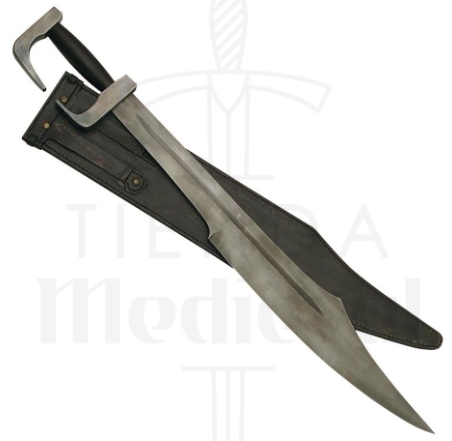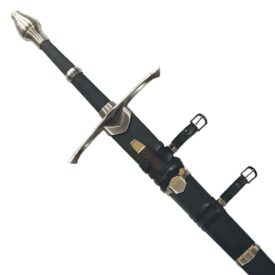The word sword comes from the Latin spatha (which also served to denote the long straight sword Roman cavalry), and this in turn from Greek spathe. Etymologically, the name remains today Sword in the épée and French as Italian as spada.

The sword is also a curved sword and a single edge, designed to cut, usually the sword was used in cavalry and officers in the nineteenth century and even XX. This character sheet curved sword traditionally difference of the sword.

Types of swords

| Cutlass | Broadleaf Sword, curved serrated on one side (or contrafilo during the last third). |
| Falchion | Sword, used in theMiddle Ages, only one edge and curved on top, near the tip. |
| Claymore | Viperus Claymore (Great Sword in British sense) were swords which needed to use both hands to be soft (upright or greatsword), sharpened on both sides of the road, possessed of a very long handle (at least one quarter of total gun), allowing the user to support it without forcing the maneuvers, or grab at the base of the leaf. |
| Scimitar | The scimitar is a weapon fine, thin and lightweight. It is decidedly sharper, with one edge and a protective handle. |
| Rapier | The term rapier sword (now also known as rapier) emerged in the Renaissance in Spain to designate some kind of sword and long straight blades, wielded in one hand. The name of the Spanish original is Tizona Rapier (not to be confused with the sword of El Cid), rapier sword is called because they carried as an attachment to clothing, usually worn by fashion and as a weapon of defense. |
| Sprat | Today sprat, is known to bethe predecessor of the sword weapon, one of the three sheets that are used in fencing. Originally, the rapier was a weapon tough, lightweight, with a piece that weighed about 750 g. |
| Rapier | A medieval sword is a narrow-bladed sword (which tapers from the handle to the tip) and always finished in a sharp point of three or more tables (sides of the blade), used most cutting-edge. |
| Falcata | The falcata is a type of weapon, an iron sword Iberia native and indigenous peoples related to Iberian pre-Roman conquest, was widely used among peoples Celt Iberians or adjacent to the first, with the sword ” antennas “more common in the most Celtic of the Peninsula. |
| Foil | The foil is a long sword, flexible, stainless steel, 500 g and 110 cm long with a rectangular sheet. |
| Gladius | Roman Gladius is the term used to describe the sword. Today is applied to the typical sword used by ancient Rome’s legions. Hea length of about half a meter (although it could do as the user), and a wide straight blade and double edged. |
| Jian | The sword Jian is the straight-bladed weapon par excellence of the Chinese people. Moderately long, double edged and virtually no cross, which has been used since historically since the 2nd millennium BC. |
| Khopesh | A khopesh, jepesh kefresh or a sword or saber with a curved blade in the form of “u” or sickle shape (depending on the period) with the edge on its convex part, used in the ancient Near East and in the area of Canaan and popularized the ancient Egypt. |
| Machete | A machete is a large knife but shorter than a sword. Typically measuring less than 60 cm and has a single edge. |
| Upright | The Stud is a broadsword of hawks too long, teachers who handle guns with both hands to separate battles in the fencing. |
| Claymore | (De Man, hand, and double.) Slash or big hit given wielding the weapon with both hands. Large sword. |
| Bastard | The bastard sword or sword hand and a half is a generic name used to describe many varietiesEuropean swords long straight blade that can be soft to medium hand (use the left to grab the sheet in its first third, or as part of his right hand on the handle) or both hands. |
| Greatsword | The term broadsword is a modern slang and call upright (right voice in Castilian). But both refer to great swords of the Middle Ages and Renaissance. |
| Ronfea | It is a long sword. |
| Sica | Curved sword originating in the region of Thrace. His only cutting edge, the inner is very sharp. |
| Spatha | The Spatha was a knife used by the Roman army during the period of decline and barbaric invasions. It originated in the first century from gladius used by infantry, granting larger (70-100 cm blade) so it could be effectively used by the cavalry. |
| Stiletto | Estoque thin crazy as that used for the bull. |
| Schiavona | It is a basket-hilted sword. Drift Schiavoni, mercenary soldiers. |

Plus types of Swords

| Cutlass | The main problem with the term “scimitar” is to correctly define what he meant really. First, its definition refers to a type of short sword Eastern Muslim descent who adopted and modified both in the peninsula and in other Christian areas of the Mediterranean. |
| Scimitar | The scimitar voice seems to come from Italian derivation “scimitarra” of Persian shams, and serves in the West to refer to any Muslim or Eastern curved saber. |
| Dao | A dao is a weapon of a single curved edge and in its several variants may or may not widen in the last third. It is one of the four big guns of the martial arts of China together with Jian, Dao, the Qiang (spear) and the Gun (staff), known in this group as the “General of all weapons.” |
| Fliss | The Fliss (flyssa) is a straight saber or sword (by convention) of North Africa, single-edged blade to its final third, which is double, which ends andn an acute tip. |
| Laito | The long sword Iaito is a “training” used for the practice of martial arts iaido or other, in place of a real katana. |
| Katana | The katana is a Japanese sword, but in Japan this word is used generically to encompass all the sabers. |
| Poluwo | |
| Saif | |
| Shams | Shams is a cutlass or saber Muslim par excellence. Curved blade and short cross hawks, its stylish curved blade regularly since its first third. Single edge rule, except in its last section, to puncture, it was a gun in one hand. |
| Talwar | The Talwar is a sword or tulwar of Hindustan, curved blade, principally single-edged and whose main characteristic that distinguishes them from other Muslim Turkish sabers feature is its handle, flattened fist, straight topped by short hawks semicircular work with fore leaving the ring side to hawk falling edge, ending a remarkable grip knob flattened circular shape and topped with natural motifs appendix. |
| Wazikashi | The wakizashi is a short swordJapanese traditional, with a length of between 30 and 60 centimeters. For shorter, almost have to talk about both, a Japanese-style knife. Its shape is similar to that of the katana, but the edge is usually thinner and therefore may more severely injure an unprotected goal. |
| Yataghan | The yatagan is a kind of sword or cutlass used in the East. It is equipped with double curvature, which facilitates the indiscriminate use of cut or tip. Contrafilo edge and a run to the outside. His grip is characterized by two protuberances on the “knob” used to called ears will not slip his hand. |








